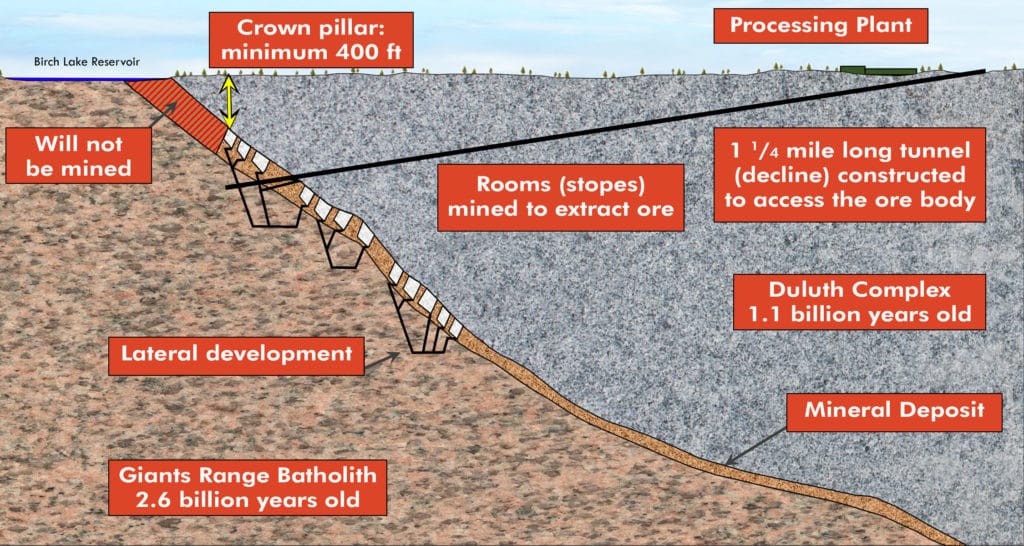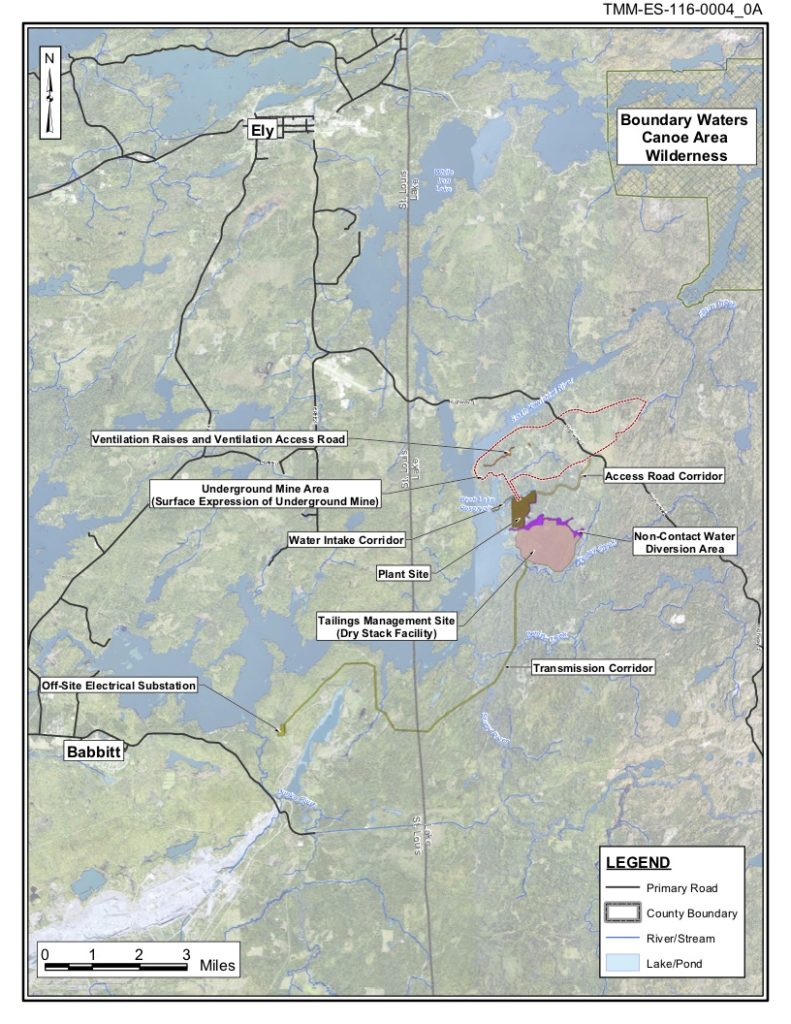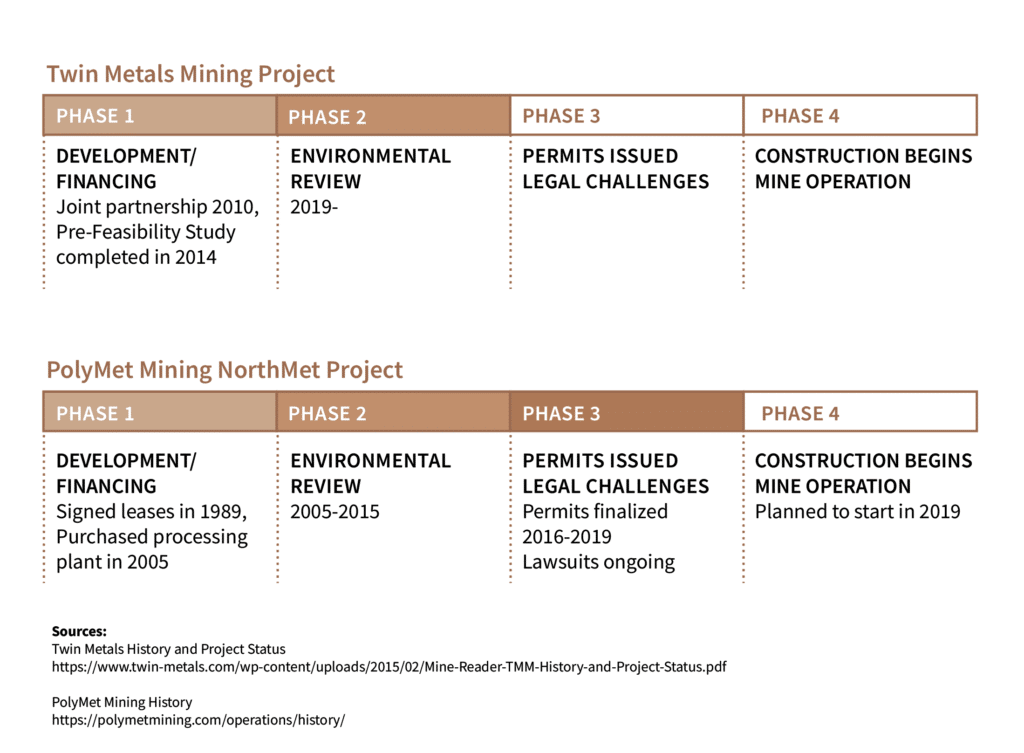[DISPLAY_ULTIMATE_SOCIAL_ICONS]


The company seeking to operate a copper-nickel mine near the Boundary Waters Canoe Area Wilderness today submitted its first major plans to seek approval from regulators. Twin Metals, owned by Chilean conglomerate Antofagasta PLC, sent a Mine Plan of Operations to the U.S. Bureau of Land Management and a Scoping Environmental Assessment Worksheet Data to the state.
The move begins what will be a multi-year review process by authorities. It will begin with scoping, a process intended to figure out the appropriate range of issues that should be analyzed in an Environmental Impact Statement (EIS). Public input will be invited at several stages, including at least a 30-day comment period once the scoping document is drafted.
“The credibility of the EIS process for the Twin Metals proposal is critical to Minnesotans,” said DNR Commissioner Sarah Strommen. “The DNR is committed to a rigorous, transparent, and neutral review of the proposal, based on science and applicable state law.”
In November, the state of Minnesota announced it would conduct an environmental review of its own, separate from the federal review.
Project details
Twin Metals says the mine proposal is built on 10 years of test drilling, analysis, and other work. The company claims it will be a “model” for modern mining without the pollution that has plagued other mines.
“We look forward to a robust period of engagement with federal, tribal and state governments and the public as we move into scoping and environmental review,” said Julie Padilla, Twin Metals’ chief regulatory officer. “Submittal of our proposal marks the very beginning of that process, and we are confident that it will ultimately result in the best outcomes for this project and for Minnesota.”
The project would be located along the South Kawishiwi River and on the eastern edge of Birch Lake, a reservoir on the river. It would be the first underground mine in Minnesota since Ely’s taconite Pioneer Mine closed in 1967, with a 1.25-mile long tunnel sloping down to the ore body from the surface. In addition to the mine itself, there would be an ore processing facility and dry stack tailings. Mining would occur 400 to 4,500 feet below the surface, with an average of 20,000 tons of ore processed each day.
Over the mine’s lifespan, half of the mine waste would be placed back underground in the mine and the other half would be stored above ground near Keeley Creek, which flows into Birch Lake.
“We need the jobs and metals this project will provide, so I look forward to seeing our miners meet or exceed every local, state, and federal environmental regulation,” said Rep. Pete Stauber, who represents the area in Congress.
‘Perilous time for the Boundary Waters’
Yesterday, anti-Twin Metals advocates called on Governor Tim Walz to stop the proposal before it is even considered. Campaign to Save the Boundary Waters opposes the project saying copper mining is too big a risk to the region’s water and wilderness. At a press conference at the Minnesota State Capitol, the organization said the legal process is not strong enough to ensure that the Boundary Waters is not polluted.
“This is an incredibly perilous time for the Boundary Waters,” said Save the Boundary Waters Executive Director Tom Landwehr. “The Trump Administration has corrupted the federal environmental review process and jammed the Twin Metals project into a state process that was never intended to protect pristine locations like the Boundary Waters. If elected leaders don’t act we could lose the Boundary Waters as we know it.”
Also yesterday, MinnPost reported that funding to complete a federal study of whether or not mining can be done safely in the wilderness watershed was cut from federal budget legislation, at the request of the White House. The Trump administration cancelled the study begun by the Obama administration in 2018, and Rep. Betty McCollum had attempted to revive it through Congress.
There are still lawsuits active in the courts challenging the renewal of Twin Metals’ federal mineral leases by the Trump administration, and other aspects of the proposed mine.
“Our clean water is precious, but state and federal agencies have not shown they are up to the task of protecting it from the threat of sulfide mining,” said Kathryn Hoffman, Chief Executive Officer of the Minnesota Center for Environmental Advocacy. “Nobody is entitled to pollute our water, and Governor Walz and the Minnesota DNR have the legal authority to protect the Boundary Waters from the threat of the Twin Metals mine.”
To the south of the Twin Metals site, the PolyMet mine this year became the first copper-nickel mine to get all the necessary permits to operate. But the project has been halted by court order while irregularities in the permitting process are investigated.
With the official submission of the proposal, the DNR has created a website dedicated to the project where all documents, fact sheets, and other materials will be available, as well as an e-mail newsletter for updates.
More information:
- Twin Metals Minnesota submits mine plan to state and federal agencies for review – Twin Metals
- DNR receives mining proposal from Twin Metals Minnesota – Minnesota DNR
- Twin Metals Minnesota Project – MN DNR
- Twin Metals Mine Plan of Operation – Twin Metals
- Save the Boundary Waters
- Minnesota Center for Environmental Advocacy


